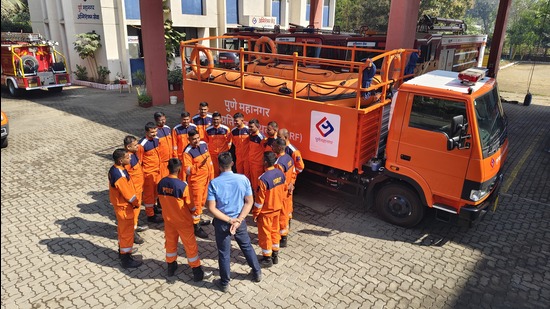Disaster response vehicles added to PDRF’s fleet
The PDRF, formed under the Pune Metropolitan Region Development Authority (PMRDA), is designed to respond swiftly to potential risks such as landslides, structural collapses
Considering the need for an effective disaster management system in the region, PMRDA established the Pune Metropolitan Disaster Response Force (PDRF). Deputy chief minister and Pune district guardian minister Ajit Pawar inaugurated the PDRF’s fleet of vehicles on Republic Day.

The PDRF, formed under the Pune Metropolitan Region Development Authority (PMRDA), is designed to respond swiftly to potential risks such as landslides, structural collapses, dam-related emergencies, and highway accidents within PMRDA’s vast jurisdiction. Equipped with state-of-the-art resources, the PDRF has been allocated ₹5 crore by the State government and initially staffed with 30 trained personnel.
Inspired by the Thane Disaster Response Force model, the PDRF was conceptualised by Pawar to enhance disaster response capabilities in Pune.
The force’s fleet includes advanced vehicles such as a 32-seater troop carrier bus, tempo, and pick-up vans. These vehicles were incorporated during the Republic Day celebrations at the Police Headquarters ground in Shivajinagar. Apart from Ajit Pawar, divisional commissioner Dr Chandrakant Pulkundwar, PMRDA commissioner and CEO Dr Yogesh Mhase, district collector Jitendra Dudi, PMRDA chief fire officer Devendra Potphode and other dignitaries attended the event.
Plans are in the pipeline to further strengthen the PDRF with trained manpower, modern technology, and robust disaster management strategies. Coordinated efforts between PMRDA, the police, and the district administration aim to position the PDRF as a model disaster management system in India.
Rapid urbanisation within the PMRDA region has led to a surge in population and an increase in industrial, commercial, and residential establishments.
While the PMRDA already has a fire brigade, a dedicated rescue and relief team was deemed necessary to handle disasters like building collapses, accidents, and heavy rainfall. Though the National Disaster Response Force (NDRF) is deployed in such situations, delays in reaching the disaster site due to logistical challenges often hinder timely interventions during the critical “golden hour.” Recognising this gap, the PDRF was established to provide a localised, rapid response mechanism similar to national and state disaster response teams, said Ajit Pawar.
Considering the geographical challenges of the PMRDA region, the PDRF aims to ensure safety and effective disaster management for its residents.






